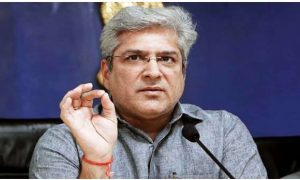ISRO chairman S Somanath said the first Technology Demonstrator Satellite (TDS-01) using indigenously developed electric propulsion will be launched in December.
Read More:-RBI Governor Shaktikanta Das Gets Top Central Banker Award
New Delhi: Indian Space Research Organisation Chairman (ISRO) Dr S Somanath on Saturday announced new dates for upcoming space missions during the Sardar Patel Memorial Lecture at Akashvani (All India Radio), as reported by The Indian Express. The Gaganyaan Programme approved in December 2018 envisages undertaking human spaceflight to Low Earth Orbit (LEO) and laying the foundation of technologies needed for an Indian human space exploration programme in the long run.
During the Sardar Patel Memorial Lecture at Akashvani (All India Radio), ISRO Chairman S Somanath indicated that the Gaganyaan manned space mission is likely to take place in 2026. The Chandrayaan-4 sample return mission is scheduled for 2028, and the long-delayed India-US joint NISAR mission is finally set for launch next year.
Read More:–Diwali 2024: Indian Railways Launches Special Train From Lucknow To Bihar
ISRO Chairman S Somanath announced that the joint moon-landing mission with the Japan Aerospace Exploration Agency (JAXA), previously known as LUPEX (Lunar Polar Exploration), will now be designated as the Chandrayaan-5 mission. However, he did not provide a specific timeline for its launch. As per the IndianExpress report, the LUPEX mission was initially slated for launch within the 2025 timeframe, but given its new identity as Chandrayaan-5, it is now expected to be launched after 2028, following the scheduled Chandrayaan-4 mission.
“It would be a very heavy mission in which the lander would be provided by India, while the rover would come from Japan. The rover on Chandrayaan-3 was only about 27 kg in weight. But this mission would carry a 350-kg rover. It is a science heavy mission which would take us one step closer to landing human beings on the moon,” Dr S Somanath was quoted as saying by IndianExpress. The Indian space agency has plans to undertake a manned mission to the moon by 2040.
Read More:–Weather Today: IMD forecasts light rain in THESE states; full details here
He even highlighted that the opening of the space sector to private enterprises, along with the introduction of new enabling policies and the enthusiasm demonstrated by young entrepreneurs, has fostered a vibrant space ecosystem in India. “But our contribution to the global space economy is still about 2 per cent. Our aspiration is to increase it to about 10 per cent in the coming 10-12 years. But ISRO cannot achieve this alone. We need participation of other stakeholders. Start-ups to big companies, all need to come and participate in India’s space sector. We have been working hard to create those enabling mechanisms that will make it easy for companies to work with ISRO,” ” Somanath was quoted as saying by The Indian Express.
According to news agency PTI report, India will test its home-grown electric thrusters to steer satellites to its desired orbit, a technology that promises to make spacecraft lighter and pack more punch, in December. Delivering the Sardar Patel Lecture at Akashvani, Indian Space Research Organisation (ISRO) chairman S Somanath said the first Technology Demonstrator Satellite (TDS-01) using indigenously developed electric propulsion will be launched in December.
The TDS-01 will also demonstrate indigenously built traveling wave tube amplifiers (TWTAs) that are integral parts of various communication and microwave remote sensing payloads on satellites.





































